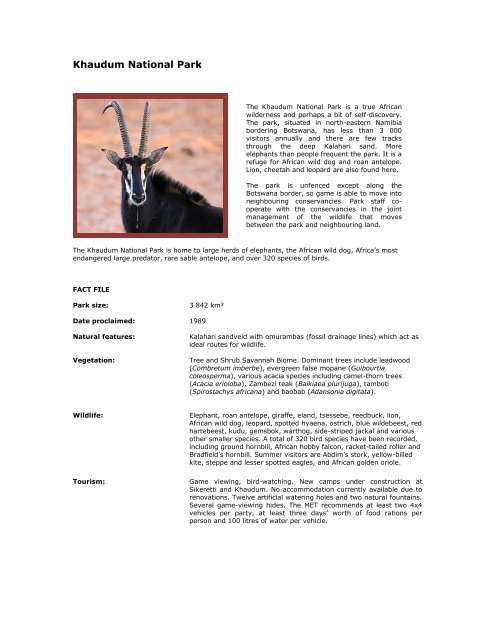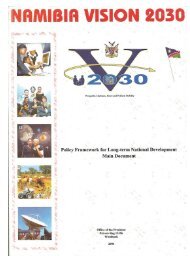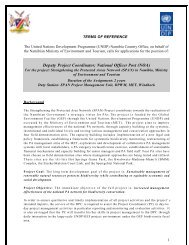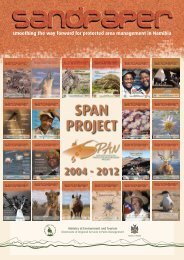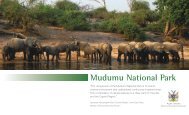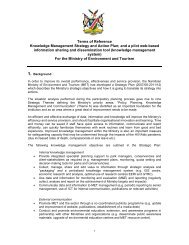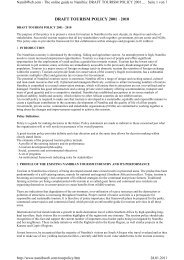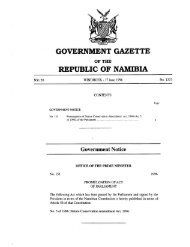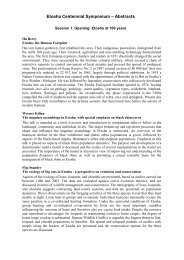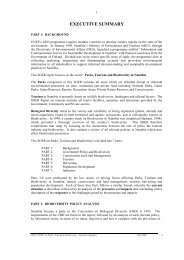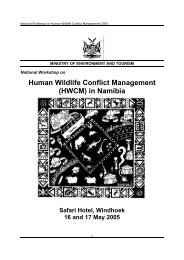Khaudum National Park
Khaudum National Park
Khaudum National Park
- No tags were found...
Create successful ePaper yourself
Turn your PDF publications into a flip-book with our unique Google optimized e-Paper software.
<strong>Khaudum</strong> <strong>National</strong> <strong>Park</strong>The <strong>Khaudum</strong> <strong>National</strong> <strong>Park</strong> is a true Africanwilderness and perhaps a bit of self-discovery.The park, situated in north-eastern Namibiabordering Botswana, has less than 3 000visitors annually and there are few tracksthrough the deep Kalahari sand. Moreelephants than people frequent the park. It is arefuge for African wild dog and roan antelope.Lion, cheetah and leopard are also found here.The park is unfenced except along theBotswana border, so game is able to move intoneighbouring conservancies. <strong>Park</strong> staff cooperatewith the conservancies in the jointmanagement of the wildlife that movesbetween the park and neighbouring land.The <strong>Khaudum</strong> <strong>National</strong> <strong>Park</strong> is home to large herds of elephants, the African wild dog, Africa’s mostendangered large predator, rare sable antelope, and over 320 species of birds.FACT FILE<strong>Park</strong> size:3 842 km²Date proclaimed: 1989Natural features:Vegetation:Kalahari sandveld with omurambas (fossil drainage lines) which act asideal routes for wildlife.Tree and Shrub Savannah Biome. Dominant trees include leadwood(Combretum imberbe), evergreen false mopane (Guibourtiacoleosperma), various acacia species including camel-thorn trees(Acacia erioloba), Zambezi teak (Baikiaea plurijuga), tamboti(Spirostachys africana) and baobab (Adansonia digitata).Wildlife:Tourism:Elephant, roan antelope, giraffe, eland, tsessebe, reedbuck, lion,African wild dog, leopard, spotted hyaena, ostrich, blue wildebeest, redhartebeest, kudu, gemsbok, warthog, side-striped jackal and variousother smaller species. A total of 320 bird species have been recorded,including ground hornbill, African hobby falcon, racket-tailed roller andBradfield’s hornbill. Summer visitors are Abdim’s stork, yellow-billedkite, steppe and lesser spotted eagles, and African golden oriole.Game viewing, bird-watching. New camps under construction atSikeretti and <strong>Khaudum</strong>. No accommodation currently available due torenovations. Twelve artificial watering holes and two natural fountains.Several game-viewing hides. The MET recommends at least two 4x4vehicles per party, at least three days’ worth of food rations perperson and 100 litres of water per vehicle.
Map
Conservation successesOnly the border with Botswana and a 55km section of the park’s western border are fenced in the<strong>Khaudum</strong> <strong>National</strong> <strong>Park</strong>. This open park system ensures that wildlife can pursue hereditary migratoryroutes to and from the water rich Kavango River and floodplains, including the Okavango Delta, a mere150 km from the park boundary. Thus wildlife migratory routes link Namibia, Botswana and Angola undera protective legislative coat. In addition, the <strong>Khaudum</strong> <strong>National</strong> <strong>Park</strong> is the only park in Namibia thatprotects the Northern Kalahari Sandveld biome, portrayed as forest savanna and woodland. The park isalso one of the few refuges in which rare and endangered species such as Roan antelope and African wilddog can roam freely, underlining the park’s important conservation status.Key management issuesWater is the main limiting factor in <strong>Khaudum</strong>, as underground water sources are limited. The park needsto deliver between 700 000 and 900 000 litres of water per day to meet game consumption needs. Thisamount will increase rapidly if the elephant population keeps on rising (currently around 3 500). This inturn could spell catastrophe, as antelope species will not be able to compete for water, making death dueto thirst likely.Seventy-two-hour full-moon game counts are conducted in September and October. Specially designedelephant cribs built at waterholes have increased water quality for wildlife, as less water is lost toevaporation and cleaner, better quality water is provided.Fires enter the park from Botswana and neighbouring communities every year, causing devastatingvegetation loss.Future PlansA concession has been awarded to the Gciriku Traditional Authority and the Muduva Nyangana and GeorgeMukoya conservancies to manage the new camps, to boost support for the park by the local communityand to acknowledge that the land was first made available for conservation by the Traditional Authority.


